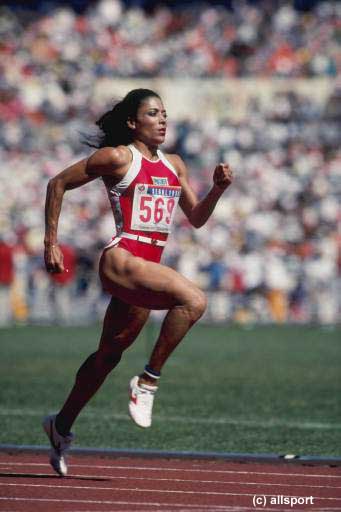
(Source of SIMI motion: Running Animation)
The Running Cycle
For more in-depth information read article, "The Art of Running."
(Note: There is a period when the runner is airborne)

(Source
of SIMI motion: Running Animation)
There are two main phases to the running cycle: Support and Forward Recovery
Support Phase: This is the phase when the runner is touching the ground, and makes up about 30%-40% of the running cycle.
Foot-strike: The foot touches the ground slightly ahead of the center of mass. When the foot contact occurs, several actions take place: the knee flexes, the tibia internally rotates, the ankle plantar flexes, and the subtalar joint pronates (Miliron & Cavanagh, 1990). It is necessary to have a certain amount of pronation to disseminate the energy of the foot-strike. The foot during the foot-strike should be straight and in line with the direction of linear motion. If the feet are turned outward it reduces the distance covered, and puts more stress on the knees and lower extremities (Williams, 1990).
Picture courtesy of
http://moon.ouhsc.edu/dthompso/gait/KNMATICS/STJOPEN.HTM
Calcaneus Talus Tibia
Mid-support: The foot transforms from a mobile structure into a rigid lever that supports several times the body weight of the runner. The shape of the bones and the tension on the ligaments, allows for the foot to remain rigid. The supination of the subtalor joint forms a rigid lever for forward propulsion. This occurs through a series of events including the knee joint extending, the lower extremity rotates externally, the calcaneus inverts, the midtarsal joint locks, and the foot becomes a rigid lever.
What is Supination? This is the opposite motion of pronation. This occurs when the ankle appears to be 'tipped' to the outside so the weight is on the outside border of the foot. Supination allows the foot to be a more stable, rigid structure for pushing off of. The foot naturally supinates during the toe-off stage (when the heel first lifts off the ground until the end of the step) to provide more leverage and to help ‘roll’ off the toes.
Take-Off: The the mid-support period ends with an uprising heel, and is called the take-off period.
100 World Record Holder Florence Griffith Joyner in take-off period

Photo courtesy of
http://www2.iaaf.org/TheSport/sport/100/intro.html
Forward Recovery Phase: This is the phase when the runner is airborne and spends most of the time. This portion makes up about 60% of the running cycle.
Follow-through: This is achieved through hip flexion and forward rotation of the pelvis, which cause the thigh to start moving forward.
800 World Record Holder Wilson Kipketer(Left) and opponent in follow-through period
Picture courtesy of http://www.oztrack.com/talented.htm
Forward swing: This is a continuation of the follow-through. Knee flexion assists in the flexion of the hips, allowing the thigh to move horizontally and the runner to prepare for a foot-descent.
Carl Lewis. Gold medal in 1984 Los Angeles Olympic Games. In forward swing period.
Picture courtesy of
http://users.pandora.be/hans.d.hollander1/Los%20Angeles%201984/statistieken.htm
Foot-descent: This occurs after maximum hip flexion is reached. The knee now extends after flexing to allow movement of the lower limb. the hamstrings are the opposing muscles that slow forward movement of the foot and leg by generating tension.
Main Page
Shoes and Support
Forces and Efficiency
Power and Friction
Bibliography